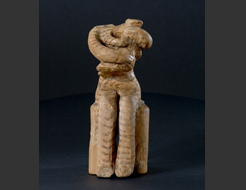|
||||||||||||||||||||||||||||||||
|
|
Museum of: Athens | |||||||||||||||||||||||||||||||
| Name of the artefact: The Kourotrophos (Nurse) | ||||||||||||||||||||||||||||||||
|
Clay figurine of a woman seated on a stool with a baby
in her arms. The group depicts a mother and baby just as she prepares to
suckle it. |
||||||||||||||||||||||||||||||||
|
WHERE IS IT AND MAIN CHARACTERISTICS |
STATE |
|||||||||||||||||||||||||||||||
|
Department: |
Prehistoric |
Preservation: |
Very good | |||||||||||||||||||||||||||||
|
Inventory number: |
5937 |
Restauration: |
No restored | |||||||||||||||||||||||||||||
|
Name of the artefact: |
The Kourotrophos (Nurse) |
Completeness: |
Almost Complete | |||||||||||||||||||||||||||||
|
Object type: |
Human figurine |
|||||||||||||||||||||||||||||||
|
Material: |
Clay |
|||||||||||||||||||||||||||||||
|
Methof of manufacture: |
Hand made |
|||||||||||||||||||||||||||||||
|
Decoration type: |
Painting |
|||||||||||||||||||||||||||||||
|
Distinctive mark: |
Nursing |
|||||||||||||||||||||||||||||||
|
DIMENSIONS |
PERIOD OF USE |
|||||||||||||||||||||||||||||||
|
Length (mm): |
- |
Epoque: |
Neolithic |
|||||||||||||||||||||||||||||
|
Heigth
(mm): |
165 |
Culture: |
Classical Dimini |
|||||||||||||||||||||||||||||
|
Diameter
(mm): |
- |
Period: |
Late Neolithic |
|||||||||||||||||||||||||||||
|
Width (mm): |
65 |
Face: |
Late Neolithic II |
|||||||||||||||||||||||||||||
|
Thickness (mm): |
- |
Absolute chronology: |
4800-4500BC |
|||||||||||||||||||||||||||||
|
Weight
(g): |
- |
|||||||||||||||||||||||||||||||
DISCOVERY |
||||||||||||||||||||||||||||||||
|
Date: |
1902 |
Country: |
Greece |
|||||||||||||||||||||||||||||
|
District: |
Thessaly |
Town hall affiliation: |
Volos |
|||||||||||||||||||||||||||||
|
Village: |
Sesklo |
Discovery findspot: |
Neolithic settlement of Sesklo |
|||||||||||||||||||||||||||||
|
Condition of discovery: |
Chance Discovery |
Discovery type: |
Deposit |
|||||||||||||||||||||||||||||
|
ANALYSES – DETERMINATIONS |
FILLED IN BY |
|||||||||||||||||||||||||||||||
|
Type: |
- |
Name: |
Alexandra Christopoulou |
|||||||||||||||||||||||||||||
|
Laboratory: |
- |
Institution: |
National Archaeological Museum - Greece |
|||||||||||||||||||||||||||||
|
No./Code: |
- |
Date: |
21/11/2005 |
|||||||||||||||||||||||||||||
|
DEEPENINGS |
||||||||||||||||||||||||||||||||
|
Morphology of the object: |
||||||||||||||||||||||||||||||||
|
The head of the seated woman, missing now, was made
separately and it was inlaid together with the neck in the hole left at
the base of the neck. The woman sits comfortably in calm, but not at
ease or in lasiness, embrassing a baby, which also seems as stuck on her.
Beyond doubt, this group presents the eternal holly couple of the Mother
and her baby. Mother’s body leans slightly forward, the baby’s arms are
round her body, the right behind on the back, the left on the breast of
the mother. The posture stabilised the preparation, the last movements
of mother and baby just before suckling. |
||||||||||||||||||||||||||||||||
|
Decoration: |
||||||||||||||||||||||||||||||||
|
Both figures are ‘dressed’ with the dark brown painted
spirals and lines, which could recall the designs which would have been
woven to the clothes. Among these designs, however, the spiral might
have been not only and simply decorative, but also, and mainly, symbolic.
The group was created and decorated to be seen from all sides. The
artist knew anatomy and some assymetries, as the long, thick lower legs,
were out of his goals, as generally this part of the body is indifferent
in the neolithic idoloplastic production. (object no. 5941: The lower
half of a clay steatopygic female figurine. The Aphrodite’s triangle has
been painted with red colour. Sesklo. Middle Neolithic Period 5800-5300
BC). Still, it is a unique artefact. It breathes vigour and simplicity,
but also sensitivity and tenderness, so that the absence of the mother’s
head is not immediately noticeable. |
||||||||||||||||||||||||||||||||
|
Inscription: |
||||||||||||||||||||||||||||||||
|
- |
||||||||||||||||||||||||||||||||
|
Analogies: |
||||||||||||||||||||||||||||||||
|
- |
||||||||||||||||||||||||||||||||
|
Interpretation: |
||||||||||||||||||||||||||||||||
|
The spiral design appeared and is typical in the Late
Neolithic Period (5300-4500 BC); its continous circles match the
reformations, the rennovations and the new approaches – evident in the
excavated sites – which constitute the basic differences and
characteristics of this period when compared to the previous ones, the
Early and the Middle Neolithic ( photo of the spherical vase no.5922 :
Clay spherical two handled vase with polychrome painted decoration;
among the motifs the spira at the centre is an innovation. Dimini, Late
Neolithc I, 5300-4800 BC). So these spiral motives could indicate a code
related to the eternal power of the circle of Life. One could go further
and connect the spiral with the spiraling/whirling of the Universe. |
||||||||||||||||||||||||||||||||
|
Bibliography: |
||||||||||||||||||||||||||||||||
|
- |
||||||||||||||||||||||||||||||||

